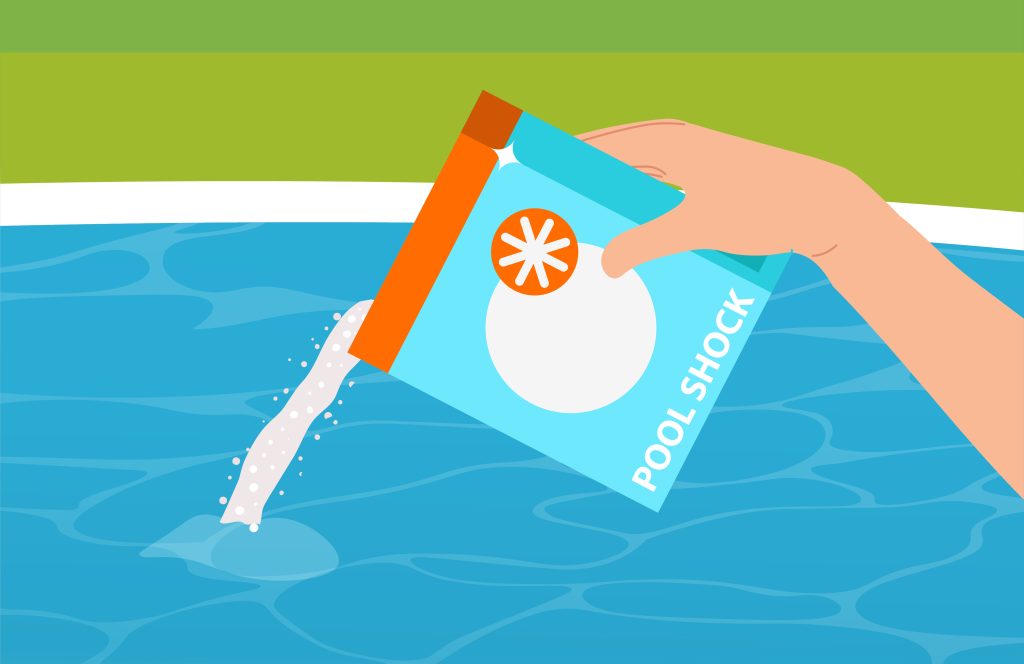Shocking your pool should be a key part of your pool’s maintenance routine. If you want to swim in a crystal-clear pool free of bacteria, algae or harmful pathogens — this article is for you. We explain everything you need to know about swimming pool shocking, including what it is, how to do it and the most frequently asked questions you need to know.
What does shocking a pool mean?
Shocking a pool refers to adding a strong concentration of sanitizing chemicals to destroy contaminates. These chemicals, known as ‘shock’, are typically chlorine based, but non-chlorine shock can also be used.
Chlorine-based pool shock is most common and is used to quickly raise the free chlorine level in the pool, instantly killing bacteria, algae, chloramines and other pathogens.
Non-chlorine pool shock is an oxidizer that kills organic contaminants, enabling the free chlorine in the pool to sanitize the water more effectively.
The benefits of using shock is that it generally provides a deeper and more sanitary clean than the standard clean you might do as part of your routine maintenance.

How to shock a pool
First you must prepare the pool for the shocking process. This entails uncovering your pool, skimming, vacuuming and brushing your pool. From there, put on protective goggles and gloves to protect yourself and you’re ready to shock.
- Test the pH level in your pool to make sure they are balanced
- Add the shock to a bucket of pool water according to instructions and stir
- With the pool pump running, pour the mixture around the edges of the pool
- Let the pump run for around six hours. Make sure you test the water before use
How long after I shocked my pool can I go swimming?
Don’t use your pool straight away after you have shocked it. Wait for the pump to run for around six hours and then test the water periodically until the free chlorine levels drop to 1-3ppm. Only then will it be safe to use.
Why is my pool still cloudy after shocking it?
If your pool remains cloudy after shocking it, it could be caused by any of the following problems:
- Your filter doesn’t work properly
- There are high levels of calcium in the pool
- You shocked the pool when it had high pH levels
- There are high level of cyanuric acid in the pool
- You don’t use a pool clarifier
It’s important to identify which of these might be the issue so that you can correct it. In most cases, the culprit will be a faulty pool filter. Replace the filter to return the pool back to a clean and clear state.
When and how often should I shock my pool?
Shocking can be done as part of your general maintenance routine, but there are also a few instances where additional shocking should be done. These are:
- If you can smell chlorine
While this may seem counterintuitive, a strong chlorine smell actually indicates an abundance of chloramines, which are an irritant and hazardous to humans.
- If you have used your pool more than usual in a short space of time
If a lot of people have used your pool in a short space of time, it might be best to start shocking. People introduce a variety of organic pollutants into the pool.
- After a bout of heavy rain
Because rain is acidic, a bout of heavy rain can alter the pH level of your pool
- If the temperature of your water has sharply increased
If the temperature rises above 88°F, it might be time to shock your pool. Warm water will destroy free chlorine and allow algae to grow and flourish.
For professional maintenance from a certified pool builder, use Aqua Blue Pools. We’ll return your pool to perfect condition, ensuring it is clean, hygienic and safe to use. As the only master pool builder is South Carolina, we know a thing or two about great pools. In addition to professional maintenance, we also design and build luxury pools for residential and commercial clients.
For all your pool needs, trust Aqua Blue Pools. Contact us today to get started.


